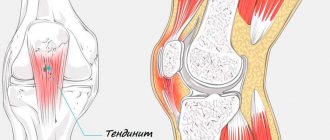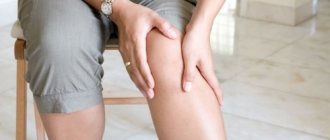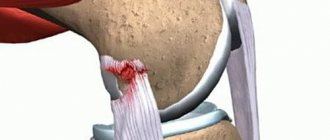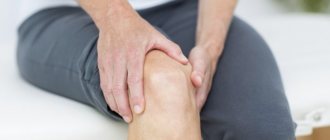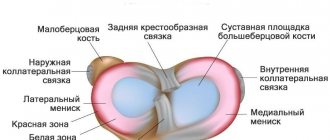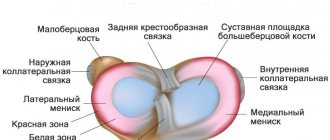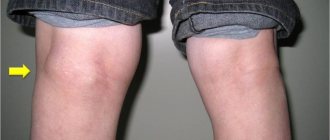What is knee tendonitis?
Knee tendonitis occurs quite often among the population, regardless of gender and age category. It is accompanied by a pathological process localized in the area of contact between the tendon and the bone. This disease is often equated to meniscus lesions - in terms of frequency of occurrence.
Most often, tendinitis of the knee joint occurs in adolescents and middle-aged people, as well as people involved in active sports activities. The disease can be acute or chronic. If treatment for the above-described ailment is not started in a timely manner, this can provoke weakening of the ligaments in this area, even to the point of their rupture.
However, restoration of damaged tissue is possible with regular and proper rest. In its absence, microdamage can provoke serious degenerative disorders, namely, tendinitis of the knee joint.
To make an accurate diagnosis and draw up a competent treatment plan, it is necessary to deal with experienced and qualified specialists. The sooner you go to the clinic, the better your chances of recovering your knee joint.
Treatment of Baker's Cyst in Naberezhnye Chelny
Only an experienced doctor can make the correct diagnosis, identify the root cause of the pathological process and prescribe adequate treatment for Baker’s cyst. At the Center for Restorative Medicine in Naberezhnye Chelny, a specialist in the field of orthopedics and traumatology can easily diagnose and treat any joint pathologies.
The cost of the clinic's services can be found by following the link. If you have any questions regarding the treatment of Baker’s cyst and other pathologies of the musculoskeletal system, you can make an appointment with a doctor by calling +7 (8552) 78-09-35, +7 (953) 482-66-62. It is important to remember that timely contact with a specialist speeds up the healing process, so don’t wait, call right now!
What causes knee tendinitis to develop?
The main reason that can provoke tendonitis of the knee joint is the increased intense load on this area of the leg. Microtraumas resulting from it can lead to a severe inflammatory process.
Also, the following factors can cause the development of the disease:
- Excessive stress on the joints that occurs when jumping, during sports jogging and when climbing stairs;
- Knee injury, flat feet;
- Insufficient flexibility of the thigh muscles, their weakness;
- A sharp increase in the intensity of physical activity;
- Rapid weight gain, obesity.
The increased risk of patellar tendonitis in women is due to having wider hips than men.
If you ignore knee tendonitis and its symptoms for a long time, and do not give up your usual lifestyle, regular microtraumas can cause significant impairment of tendon function, and also lead to their complete destruction. In the event of serious complications, which include tendinosis, pain can continue for several years and provoke rupture of the damaged tendon.
Causes
Inflammation is often triggered by jumping and is considered an occupational disease of athletes involved in volleyball, tennis, basketball, athletics, and football.
In sports medicine, there is a term called “jumper’s knee.” Provoking factors for the development of the disease are:
- heavy weight;
- jumping on a hard surface;
- flatvalgus feet;
- incorrect posture;
- shoes not suitable for sports;
- long-term antibiotic therapy;
- systemic diseases (rheumatoid arthritis, scleroderma, gout, diabetes);
- increased cholesterol levels in the blood;
- endocrine pathology.
Symptoms of knee tendinitis
Pathological processes in the tendons located in the area of the knee joint are most often accompanied by the following symptoms:
- Pain in the area above the tendon. Increases with jumping and jogging;
- Feeling of stiffness in the knee joint in the morning. Caused by a decrease in elasticity at the site of the lesion;
- Thickening of the damaged ligament;
- In the acute form of the disease, severe swelling occurs in the area of the soft tissues located around the tendon. The temperature of the skin above it may also increase and beauty may appear;
- A cracking sensation in the knee joint when squatting or walking.
Pain increases gradually as physical activity increases. The most sensitive area is the area above the damaged ligament.
Make an appointment Online booking
- Clinic on Krasnopresnenskaya +7 (499) 252-41-35 Volkov lane, 21
- Clinic on Varshavskaya +7 (499) 610-02-09 Varshavskoe highway, 75, building 1
- Clinic in Annino +7 (495) 388-08-08 Varshavskoe highway, 154, building 1
Surgery
Surgical removal of Baker's cyst of the knee joint is carried out according to certain indications:
- ineffectiveness of drug and physiotherapeutic treatment;
- excessively large size of the tumor;
- presence of signs of rupture of the cyst membrane;
- signs of necrotic changes in the popliteal fossa;
- impairment of motor functions in the knee joint.
Surgical removal of the tumor is performed in one of the following ways: traditionally, using an arthroscope or laser.
Traditional removal is performed under local anesthesia. The doctor makes an incision over the cyst, isolates it and resects it. After removal, the surgical wound is inspected, the blood vessels are coagulated and sutured layer-by-layer.
Arthroscopy involves minimally invasive surgical removal of a Baker's cyst. During the operation, soft tissues are practically not injured and blood vessels are not damaged. The cyst is removed using special instruments. The entire process is displayed on the monitor, as a micro-video camera is inserted into the knee joint.
The laser provides high temperature - up to 800 ° C, with which the cyst is coagulated. The liquid contents are evacuated, and a light guide is inserted into the cyst cavity. Next, it is heated and the walls of the cavity are glued together.
Stages of development of knee tendinitis
The lack of ability of the tendon to absorb increased loads provokes its damage. The disease is characterized by 4 stages, depending on the severity:
- Reactive tendonitis. Tissues have a normal ability to adapt to injury. Pain syndrome occurs exclusively after exercise, while the functions of the knee joint are not impaired.
- Tendon dysfunction. In this case, degenerative processes prevail over restorative ones. Discomfort is present both during the period of exercise and after it. The patient is able to lead an active lifestyle. If further damage to the ligament is prevented, experts give good prognoses.
- Degenerative tendinitis. It is characterized by the presence of pain during and after exercise, and the death of damaged cells. The amount of movement in the joint decreases. Without treatment, it becomes impossible to restore the function of the affected knee and return to sports activities.
- Tendon rupture. Acute pain appears in the area of the joint. It is characterized by complete loss of function of the knee joint and loss of its motor activity. If acute knee tendinitis occurs, treatment can bring the desired result only after surgery.
Localization of injury
More often, the external or internal lateral (lateral), anterior and posterior cruciate ligaments of the knee are subject to ruptures.
The location of the injury depends on the strength and direction of the excessive mechanical force applied to the knee:
- in a side impact, the lateral ligaments are more often damaged;
- with excessive knee flexion - anterior cruciate;
- with excessive extension - posterior lateral.
The doctor makes the initial conclusion about the extent of the injury and the location of the injury based on questioning the patient about the circumstances of the injury.
Diagnosis of knee tendinitis
In order to accurately diagnose the disease, you should contact competent specialists. In this case, the mandatory procedures are:
- Carrying out research in laboratory conditions. They allow you to track violations if the cause of the disease is any infectious process or rheumatoid damage to the cartilage tissue of the joint;
- X-ray. It is considered an effective way to identify the disease only when it is acute in nature, associated with the accumulation of uric acid salts or the appearance of bursitis;
- Ultrasound. Makes it possible to diagnose a disorder in the tendon structure;
- MRI, CT. Allows you to detect damage in the area of ligaments.
Only if the disease is detected in a timely manner can its stage be accurately determined and the correct treatment prescribed.
4. Treatment of the disease
First aid for tendinitis
is to stop the traumatic impact and give rest to the damaged part of the body. You can apply cold to the area of the damaged tendon. Local anti-inflammatory and analgesic ointments or anti-inflammatory drugs will help cope with pain.
If the condition does not improve within a week after tendinitis begins, see your doctor. Perhaps more serious methods are needed to treat tendonitis. It can be:
- Corticosteroid injections. This injection will quickly help reduce inflammation and pain;
- Physiotherapy. Physical therapy is very helpful for tendonitis. Especially with shoulder tendonitis. This group also includes splinting the damaged area of the body.
- Surgical treatment of tendonitis. Tendinitis is rarely treated surgically, only when other methods of treating tendonitis do not produce any results.
If you are treating tendonitis at home, you should contact your doctor immediately if any of the following symptoms appear:
- Heat;
- Swelling, redness and warmth in the tendonitis area;
- General deterioration in health;
- Inability to move the affected part of the body.
All of the above symptoms may be signs of another health problem that requires careful diagnosis and treatment.
Treatment of knee tendinitis
If a patient is diagnosed with knee tendinitis, treatment involves the use of several techniques. Their choice depends on the degree of the degenerative process. The most popular of them are:
- Use of medications;
- Performing physiotherapeutic procedures;
- Surgical procedures;
- Alternative treatment for knee tendinitis;
- Exercise therapy.
Often, as an additional method to facilitate the functioning of the joint and fix the muscles, special knee orthoses and self-adhesive tapes are used.
Treatment of tendonitis with shock wave therapy
The most effective method of eliminating inflammatory processes in the tendon area is shock wave therapy. Using this technique, it is possible to quickly deal with calcium deposits and eliminate the need for surgical intervention.
SWT for tendonitis is an innovative method that allows you to obtain the following positive effects:
- Relieve and then completely eliminate pain;
- Destroy calcium deposits;
- Restore metabolic processes;
- Normalize blood circulation in the affected area;
- Eliminate inflammation;
- Restore motor activity.
You can achieve positive dynamics and get lasting results after the first sessions of the procedure. Their frequency and intensity are selected individually. At the same time, timely contact with a specialist is of particular importance, which makes it possible to achieve a lasting healing effect in more than 90% of cases.
Our staff consists of specialists of the highest category who are fluent in working with innovative Swiss equipment, which is the key to effective treatment of knee tendinitis through shock wave therapy.
Read more about treatment of tedinitis with UVT »
Use of medications (ointments)
If you have been diagnosed with tendinitis of the knee joint, treatment of the disease can begin with taking medications that are aimed at relieving pain and eliminating inflammation. These include Diclofenac and Ibuprofen. These drugs relieve pain and eliminate the source of inflammation. If you have tendinitis of the knee joint, the above remedies can be used not only orally, but also in the form of an ointment .
When diagnosing an acute inflammatory process, it is advisable to use antibacterial therapy. Corticosteroid injections are also recommended to reduce pain.
Make an appointment Online booking
- Clinic on Krasnopresnenskaya +7 (499) 252-41-35 Volkov lane, 21
- Clinic on Varshavskaya +7 (499) 610-02-09 Varshavskoe highway, 75, building 1
- Clinic in Annino +7 (495) 388-08-08 Varshavskoe highway, 154, building 1
Surgery
If a patient has been diagnosed with knee tendinitis in an advanced stage, treatment is performed exclusively through surgical procedures. During them, damaged tissue in this area is removed.
When diagnosing calcium deposits in the affected area, arthroscopy is performed. During this procedure, the surgeon makes small incisions through which the growths are removed.
In the case of cyst-like formations, open surgery is performed. Curettage is also practiced in the area under the knee joint, which allows you to start the process of tissue regeneration.
Also, tendinitis of the knee joint involves treatment by reconstruction. This promotes rapid restoration of tendon function. In this case, at the time of the intervention, partial and complete removal of loose tissue located under the kneecap is carried out and it is transplanted into the area where the tendon attaches.
Alternative treatment for knee tendinitis
Regardless of the stage at which you are diagnosed with knee tendonitis, only a competent specialist should evaluate the symptoms and prescribe treatment. Even taking into account the effectiveness of folk remedies, their help should be resorted to only in combination with medications.
For tendinitis of the knee joint, you can treat with ointments, as well as use herbal remedies intended for oral administration. They help relieve pain, improve the functioning of the immune system and help normalize the general condition. If they are used correctly, relief comes much faster.
Oral products:
- Ginger. Infuse crushed rhizomes in a thermos and 300 ml of boiling water. Take 1/3 of the contents 3 times a day;
- Curcumin. Allows you to relieve pain. Used as a seasoning;
- Walnut. 1 glass of partitions is poured with 0.5 liters of vodka. The infusion period for the composition is 21 days. To achieve maximum effect, take 20 drops 2 times a day;
- Bird cherry. 20 g of fresh berries are poured into 1 glass of boiling water. Take 50 ml 3 times a day.
External means:
- Use of ice. Experts advise doing a daily massage of the affected area with an ice cube. The duration of the session is 15 minutes;
- Aloe. Take the leaves of the plant and place it in a cool place for 24 hours. Next, the raw materials are crushed and squeezed. A gauze pad soaked in aloe juice is applied to the affected area for 3 hours. Compresses should be changed several times a day;
- Arnica. An ointment made from crushed berries and melted fat is effective. Rub the resulting product onto the sore spot 2 times a day. It allows you to quickly eliminate swelling and inflammation.
Exercise therapy for knee tendonitis (exercises)
There are specially designed exercises that demonstrate increased effectiveness for knee tendinitis. They are recommended to be performed during the recovery period after an illness. Gymnastic exercises are carried out daily until the pain syndrome is completely eliminated. Below we will talk about them in more detail:
- While in a side-lying position, lift both legs. To achieve the desired result, you should do at least 5 repetitions. With each session you can increase the number of exercises;
- Lie down on your back. Raise your leg up at a 90 degree angle. To get maximum effect you should do about 5 repetitions. Similar movements must be made with the second leg;
- Lean against the wall. Press the ball with your knees. Do the exercise many times.
- While sitting on a chair, raise and lower your legs.
- Take regular walks.
Make an appointment Online booking
- Clinic on Krasnopresnenskaya +7 (499) 252-41-35 Volkov lane, 21
- Clinic on Varshavskaya +7 (499) 610-02-09 Varshavskoe highway, 75, building 1
- Clinic in Annino +7 (495) 388-08-08 Varshavskoe highway, 154, building 1
Rehabilitation after treatment of knee tendinitis
Once a patient has been diagnosed with pes anserine tendinitis of the knee joint, the main goal of treatment should be the full restoration of motor activity of the leg.
In this case, it is advisable to use exercise therapy programs aimed at increasing endurance, mobility and flexibility of the lower limb. Rehabilitation experts recommend performing the following exercises:
- To increase flexibility in the initial stages of recovery, it is necessary to do static stretches. During this process, it is important to hold one position for 30 seconds. In this case, the ligaments are gradually stretched;
- In the future, it is necessary to include dynamic stretching in the treatment complex. These are exercises characterized by active movements. They also help stretch the muscles and help relieve tension in them;
- Strengthening exercises for muscles are considered especially effective. They help eliminate tension in the affected area.
An important point is to avoid exercises that increase pain. Some patients use tight bandages and special knee pads, which help realign the position of the kneecap and eliminate tension in the area of nearby ligaments.
If the rehabilitation course is chosen correctly, the patient’s physical activity can be restored in 2-3 months.
Baker's cyst symptoms
The initial stage of the formation of a Baker's cyst does not bring any unpleasant sensations to a person. Symptoms increase as the tumor grows larger. Pain occurs when nearby nerve fibers are compressed. Involvement of nerve endings and surrounding soft tissues in the process entails a number of unpleasant symptoms:
- tingling feeling in the lower part of the leg;
- numbness of the sole;
- restriction in movement;
- feeling of fullness under the knee;
- edema;
- pain that intensifies with physical activity, walking;
- a change in skin pigmentation, first over the area of the cyst, and then throughout the entire limb.
The insidiousness of Baker's cyst is that a long asymptomatic course is followed by rapid growth and the development of complications.
Lack of medical treatment causes:
- Atrophy of the lower leg muscles due to compression of blood vessels and nerves. The patient experiences constant pain, so he spares the leg and limits physical activity. The imaginary calmness of the limb gives less pronounced unpleasant sensations.
- Disorder of local sensitivity, the appearance of trophic ulcers. Impact on the surrounding feeding vessels and disruption of innervation invariably provokes the development of thrombophlebitis, and in severe cases, gangrene, which is difficult to treat conservatively.
- Compression of the knee vein leads to stagnation of venous blood, subsequently phlebitis, thrombosis and varicose veins.
- Rupture of the cyst membrane. A serious condition, which is accompanied by severe swelling of the lower leg, intense pain, and increased body temperature.
- Thromboembolism and ischemia are the most severe complications that can lead to death.
Upon examination and palpation of the cyst, a somewhat painful oblong neoplasm under the knee is determined, which has an elastic, dense structure. The size of the tumor can vary from small to large. In the early stages of a cyst, the skin over it does not change color.
Preventive actions
As you can see, pes anserine tendinitis of the knee is treatable. However, it is easier to prevent the development of this insidious disease than to then waste energy searching for a professional specialist and asking questions like: “How to treat tendinitis of the knee joint?” To do this, you should follow simple rules of prevention. These include:
- Avoid prolonged stress on muscles;
- Warm up your muscles before starting a sports workout;
- Try to get proper rest after any physical activity;
- Eliminate any possibility of knee injury;
- Try to bend your lower limbs when lifting weights.
By adhering to the above recommendations, you can avoid the development of tendonitis in the left knee joint or prevent the appearance of a pathological process in the right tendon.
Prevention
Since the disease often occurs as a result of increased load on the joints, experts recommend following the following preventive measures:
- Before playing sports, you need to do a proper warm-up;
- loads should be gradual;
- if pain occurs during exercise, then you should stop doing it;
- It is not recommended to constantly load the same joints;
- Pay special attention to the condition of the leg muscles, which protect the joint from overload.
Also, do not forget about such problems as excess weight and poor nutrition. Compliance with the basic rules of a healthy life will protect not only from tendinitis, but also other pathologies.
Prognosis for treatment of knee tendinitis
If, after detecting tendonitis of the knee joint, the correct treatment is selected, as reviews indicate, dangerous consequences associated with tendon rupture and complete loss of motor activity can be avoided.
According to doctors' forecasts, the likelihood of restoring movements of the knee joint is determined depending on the stage of the pathology:
- Stages 1, 2. It is possible to completely restore motor activity through conservative methods;
- Stage 3. The possibility of full recovery is difficult;
- Stage 4. You can hope for positive dynamics, but surgical intervention is required.
The outcome of treatment can also be predicted depending on the time of its start - the earlier tendonitis is diagnosed, the greater the patient’s chances of restoring tendon function.
